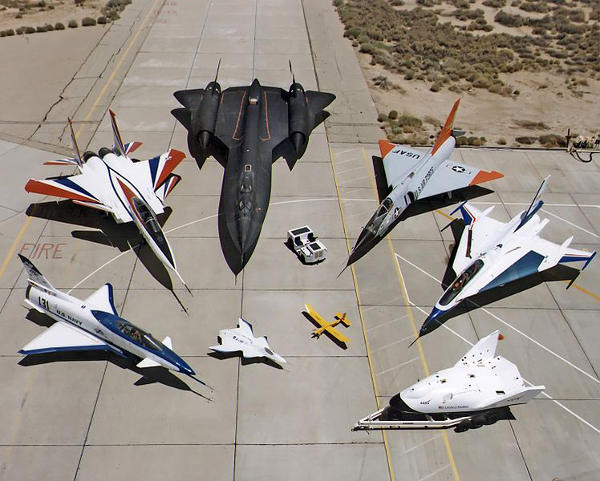NASA has played a very important role with the United States Air Force, Navy and commercial military/aerospace companies in researching flight dynamics, propulsion, special materials, aircraft design, etc.

This NASA photo includes an interesting cross section of its research aircraft. Starting on the left and going clock wise, the major aircraft are:
Rockwell-MBB X-31
The Rockwell-Messerschmitt-Bölkow-Blohm X-31 was a test platform designed for validating thrust vectoring engine technology for DARPA, NASA and the German Aerospace Center (DLR). Two X-31 Enhanced Fighter Maneuverability planes were built and 500 test flights were conducted between 1990-95.
McDonnell Douglas F-15 STOL
The F-15 STOL/MTD (Short Takeoff and Landing/Maneuver Technology Demonstrator) was a modified F-15 Eagle. This technology demonstrator was used by NASA and the US Air Force to study thrust vectoring and maneuverability. The single testbed was later used for the F-15 ACTIVE (Advanced Control Technology for Integrated Vehicles) to further study enhanced aircraft maneuverability.
Lockheed SR-71 “Blackbird”
This super-secretive Mach3+ strategic reconnaissance aircraft originated from Lockheed’s famous Skunk Works secret projects program. NASA’s Dryden Flight Research Center based out of Edwards Air Force Base in California flew SR-71 Blackbirds between 1992 and 1999, when the “Blackbird” was retired from service.
Convair F-106 Delta Dart
The F-106 was an all-weather-interceptor inducted into service with the USAF in 1959. The drone version of the aircraft (QF-106) was used by NASA in the late 1990s at Dryden Flight Research Center at Edwards, California as part of project Eclipse. It demonstrated the ability to tow and launch a reusable launch vehicle from behind the towing airplane.
General Dynamics F-16XL
This cranked-arrow delta wing version of the USAF (and NATO) workhorse F-16 Fighting Falcon was developed to compete in the Enhanced Tactical Fighter requirement of the USAF. After losing out to the F-15E Strike Eagle, the two F-16XL planes were used by NASA to test various flight characteristics and performance measures. One of the prototypes even attained supercruise during NASA testing at Dryden Flight Research Center in California.
X-38 Crew Return Vehicle (CRV)
NASA’s X-38 was conceived as a family of vehicles to be used with the International Space Station (ISS). It included collaboration with the ESA and the German Space Agency (DLR). The wingless lifting body re-entry vehicle conducted its first test flight in 1999 but the program was cancelled in 2002.
McDonnell Douglas/Boeing X-36
The X-36 was a prototype remotely piloted concept jet, designed to 28% scale of a fighter aircraft. Two prototypes were built and the program, which included NASA’s Ames and Dryden Research Centers, was completed in November 1997 having successfully demonstrated its tailless fighter design. Some additional testing was done in 1998 after which the two sub-scale technology demonstrator aircraft were shelved.